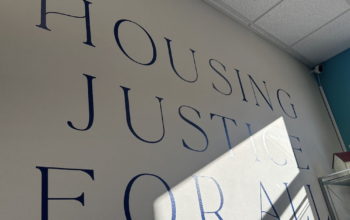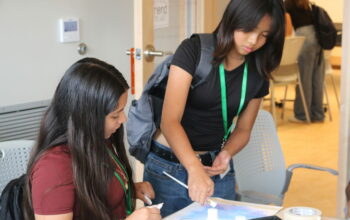This story is part of a Madison Commons series produced by master's students in the School of Journalism and Mass Communication. These stories explore how people in Madison and Dane County find different ways to develop cultures within our community, looking look for opportunities to draw connections with each other to learn more about our world.
If you ever happen to forget your days of the week, the kids in the toddler room at Safari Family Child Care in Cross Plains can enthusiastically remind you — and in two languages.
A bilingual English and Spanish day care in western Dane County, it’s part of a growing number of child care centers that offer second language learning — and with it — early exposure to other cultural traditions.
The Madison area, inviting individuals from around the world with its university, active lifestyles and diverse organizations, sits at an intersection (and upon the land) of other cultures. For area day care centers, this provides a rich opportunity for child-centered growth.
A growth in centers
Emily Pink, director of Madison College’s early childhood education program, said, “There’s been an explosion of language immersion programs in the past five years.”
What’s driving it? Pink cites both parental interest as well as current research on the benefits of language on the developing mind, including “giving them a window to look at others and learn compassion and understanding for others raised in a different way,” Pink said, referring to the concept of “windows and mirrors” advanced by an earlier child development study by Emily Style which emphasizes the frames by which a child understands the world — and others — around them.
It’s also good for the brain. Guidance from the American Academy of Pediatrics and American Speech-Language-Hearing Association states that bilingual education supports “superior problem solving and multitasking skills and increased cognitive flexibility.” According to the organization, common myths that dual language programs will confuse the child or lead to speech disorders are unfounded.
Madison College is encouraging this growth, planning educational programs taught entirely in Spanish and integrating diversity, equity and inclusion into every class.
A recent three-year, $2.9 million workforce preparedness grant is helping to fund a Spanish-only educational track, for child care providers “who are Spanish speaking, and not able to take the classes that they need to qualify,” Pink said.
Not just Spanish
While English-Spanish programs are most common, other language programs exist. One is the Hoocąk Waazija Haci, the language division of the Ho-Chunk Nation
With a mission of continuing the tribal nation’s language and customs through outreach, apprenticeships, Eminent Speakers and early childhood education, the division provides a rich set of resources for educators and students.
Wanikrohamot'aiga, a longtime educator and teacher in the early childhood program, collaborates with colleagues to develop online resources including videos, worksheets and games. She also creates her own stories, weaving together threads from other speakers to present lessons and stories in Hoocąk, the Ho-Chunk language.
"And we see results," said Wanik, as she is known for short, who also works with Head Start programs and other first-language schools as part of the program.
"Hearing and listening are the first ways we learn language, and infants and children of all ages are learning through what they see,” Wanik said. “It’s the little ones that are going to carry the language into the future, their parents too."
The link to home
It’s a sentiment shared by Yarit Moreno and Araceli Martinez, who founded Safari Family Child Care nearly one year ago, having met at another bilingual center. “We have parents who send us recordings of their child asking, ‘What are they saying?’ That relationship is important.”
Moreno added, “Our philosophy is all about family, it’s not just a business for us. Even our teachers — we’re a big family.”
Safari’s teachers hail from a range of Spanish-speaking countries like Argentina, Colombia and Mexico, and the curriculum features conversation, labels, food and books in both languages.
And it’s that parental involvement that cements the learning, according to Madison College’s Pink. “You can teach a child a second language, but if you don’t do the next step, continuing it at home, they will lose it.”
Beyond language
One of the most diverse mix of cultural backgrounds at an area day care can be found on the University of Wisconsin-Madison campus at Eagle’s Wing Child Care and Education Programs, which serves families from UW-Madison’s University Apartments, a set of neighborhoods housing graduate students, staff and faculty from dozens of nations.
Pink said there are so many cultures and languages represented at the center, the children don’t even need to understand what the others are saying.
“They can communicate nonverbally,” Pink said. “And that’s beautiful.”
Eagle’s Wing director, Paula Zipperer, agrees. The center’s teachers, she said, are pivotal to their atmosphere of inclusiveness.
“Our teachers foster a sense of openness, curiosity and kindness to each other and to the children and families we serve," Zipperer said. "Seeing children put the skills they are learning into practice, figuring out how to take turns and be kind to each other is our success story.”
The bigger impact
Early childhood education is a tough business, with high expenses, hiring stresses and small profits. Combined with the effects of COVID-19, in which more than half of U.S. day care centers were forced to close, according to the Bipartisan Policy Center, a Washington, D.C., think tank. One may wonder why a center might offer anything extra, like other languages, at all.
“Why not?” asked Martinez of Safari Family. “The United States is filled with many people, many cultures — everyone’s different…We grew up speaking both languages at home, and I know I wanted that for my own son.”
Empathy is powerful, Pink said, and fostering it in developmentally appropriate ways will lead to more enlightened adults.
“These kids learn that differences are part of life and everybody has a different way of celebrating life,” Pink said.





